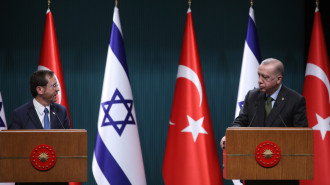

Israel's use of sonic warfare is nothing new for citizens of Lebanon, but recent months have been unprecedented.
“It sounds like the plane engine is about to crash on top of you, and then there's a boom that feels like an actual explosion. The whole building shakes. My body shakes,” recounts Nayla Kombarji* who, like anyone living in Beirut this summer, or in Lebanon’s south, has been subject to dozens of sonic booms by Israel's air force.
“Some days they’re back-to-back, like six in one hour. They've been flying really low. It's terrifying.”
There have been, at the very least, 111 sonic booms across Lebanon between 7 October and 20 August, the vast majority occurring between June and August, according to The New Arab’s analysis of Lebanon’s National News Agency (NNA).
However, given that many of NNA’s news reports refer to ‘multiple flybys’, the actual number of sonic booms could be double or triple that figure. While such tactics have been used by the Israeli Air Force for over a decade across Lebanon, never have there been so many, so consistently.
In typical fashion, Lebanese social media has been littered with jokes around the “annoyances” of Israel’s sonic booms - or “firecrackers”, as some have called them. For example, one popular meme gives readers a dark, but amusing, crash course in differentiating between missiles, sonic booms, and earthquakes, all three of which have hit Lebanon in recent months.
Or take the Lebanese teenager who runs a popular TikTok account called "Jidar l Sot" (sonic boom) that remixes each day’s blast with reverb, slow motion or reverse play.
Other parts of Lebanese social media have been more practical, with one popular Instagram story sharing tips to help people protect their buildings from sonic booms: 1) Keep windows and glass doors slightly open to reduce pressure from the sonic booms. 2) Replace any cracked or broken glass. 3) Repair any cracked ceilings. 4) Avoid placing furniture or floor lamps near beds. 5) Ensure that cabinets, bookshelves, false ceilings, and water heaters are securely fastened.
“What is very rarely spoken of is the fortitude the Lebanese people have developed over the years to Israel’s sonic warfare, the ways in which they’ve learned to cope with these attempts to break their spirit,” says Nasser Elamine, a Lebanese analyst and researcher.
“In the south, the Lebanese even have nicknames for [Israeli drones and planes], and when their engines are heard they are met with [jeers and jokes] such as ‘pass by and have a cup of tea with us’. Meanwhile, Israel’s warning messages blasted at night from drones floating near civilian buildings are drowned by chants in support of resistance,” explains Elamine.
To harm and to influence
When a plane travels faster than the speed of sound, a powerful compression of air is formed across a very small space and medium, thereby creating an air blast known as a sonic boom. Sonic booms are also caused by the detonation of an explosive, which is why some might struggle to tell the difference.
The first sonic boom to have ever been recorded was in 1947 when a US aircraft (driven by the famous Charles “Chuck” Yeager) broke the sound barrier in a historic run.
Twenty years later, in the 1960s, the US Air Force conducted its first tests on sonic booms, overseeing some 1,200 blasts over Oklahoma as part of its Cold War era experiments on civilian populations (in conjunction with NASA), says Mohamad Safa, associate lecturer at the Royal College of Art, where he specialises in sound and armed conflicts.
Fast forward two decades and the US was using sonic booms as intentional military weapons, the first one on record taking place in Nicaragua. While they have been deployed frequently in the years since Nicaragua, there is still no official (or public) US military manual on how and why sonic booms should be used, nor is there any legal clarity around their use, both in US and international law, explains Safa.
“Today, in Lebanon, sonic booms are being employed as a form of psychological warfare. The purpose is to remind the residents of Lebanon of the very real, material, tangible, and lethal consequences of standing behind the resistance,” says Elamine.
“Imitating the sound of an explosion, sonic booms exploit the traumas many residents of the country share (due to previous wars, terrorist attacks, the 2020 port explosion, etc) with the aim of suspending civilians in extended states of terror and anxiety, constantly anticipating death and destruction. The amount and intensity of sonic booms have increased as the threat of escalation becomes more likely. It is almost akin to an auditory audition for what is to come in case the war escalates.”
|
|
Nayla Kombarji* recounts that the most stressful part of the sonic booms has been the space in between the blasts, the “anticipation of when we’ll be hit by the next one”. People in Beirut were already “jumpy” as it is, but now it is really noticeable, she adds.
The Beirut port explosion of 4 August 2020 was the largest urban explosion in human history (outside war), killing more than 200 people and injuring thousands. Since 7 October 2023, Israel and Lebanon’s armed political party, Hezbollah, have been engaged in a low-level conflict that, in recent months, has almost escalated into all-out war, not least after several high-profile drone assassinations of Hezbollah leaders in Beirut and southern Lebanon.
Through the sonic booms, Israel hopes to make the Lebanese population fearful and angry, thereby pressuring the government or Hezbollah to stop fighting back, says Safa.
“Israelis have a strange way of being loved if they think bombing Lebanon will turn people against Hezbollah,” says Nadim Shehadi, a Lebanese political analyst and a fellow at Chatham House.
“Whatever Israel wants to achieve, by terrorising the population with sonic booms, actually plays into the hands of Hezbollah. For example, the big sonic booms that happened right before Nasrallah’s speeches last month only made him more popular.”
"Today, in Lebanon, sonic booms are being employed as a form of psychological warfare"
From Palestine to Lebanon
The Lebanese government has consistently condemned Israel's sonic booms as illegal, calling them a form of collective punishment, as per the Geneva Convention relative to the Protection of Civilian Persons in Time of War (which, in article 33, proscribes the intentional intimidation of a civilian population).
Sonic booms are also a breach of Lebanon’s territorial sovereignty and a violation of UNSC resolution 1701, adopted following the 2006 Hezbollah-Israel war, which lasted 34 days and left 1,100 Lebanese nationals and 165 Israelis dead.
Since 2006, Israel has routinely violated Lebanese airspace. In fact, since that year there have been more than 22,000 Israeli air violations in Lebanon, according to Earshot, a non-profit that conducts audio analysis to track human rights abuses and state violence.
Lebanese citizens living in the south of the country, or the Bekaa valley, have borne the brunt of these intrusions, with many now intuitively recognising the sound of Israel's MK drones, for example.
“Due to everything the Lebanese have been through, many have developed a hypersensitivity to sound, as linked to post-traumatic stress disorder,” says Safa. “The sonic booms trigger intrusive memories of trauma. Even exhaust pops and door slams can do this, let alone a blast.”
The re-triggering of these traumas is the main cause of harm, as opposed to the sonic booms themselves, according to Safa. This is why, when the US conducted its Oklahoma tests in the 1960s, it did not find significant psychological impacts on the civilian population, as they were not a demographic already traumatised by war and explosives.
One of the most documented cases of trauma caused by sonic booms was in the 2006 Israeli war on Gaza, says Safa.
“After the kidnapping of Gilad Shalit, Israel launched a flurry of low-flying intentional sonic booms over Gaza for a couple of days, leading to some structural damage to buildings,” he says.
“Israeli charities, Physicians for Peace, and B’Tselem found that Gazan civilians developed very severe responses to these sonic booms, including severe anxiety, women having miscarriages, and a host of other symptoms that are very close to what we know as post-traumatic stress disorder.”
*Name has been changed at the request of the interviewee
Sebastian Shehadi is a freelance journalist and a contributing writer at the New Statesman.
Follow him on Twitter: @seblebanon
Chiri Choukeir is a freelance journalist/photojournalist with work in Lebanon's An-Nahar and L'Orient le Jour newspapers




 Follow the Middle East's top stories in English at The New Arab on Google News
Follow the Middle East's top stories in English at The New Arab on Google News


